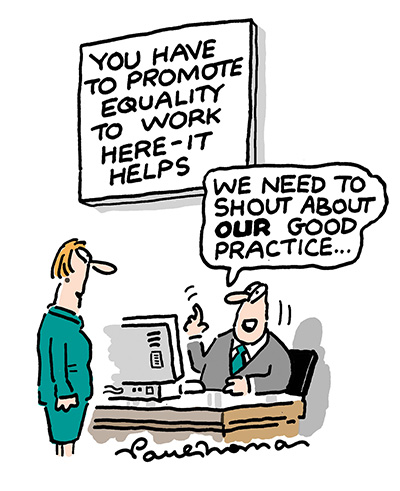How to be an inclusive leader
With the need to create a more inclusive culture high on the NHS agenda, here’s ten tips on how to champion diversity in the workplace.

1. BE POSITIVE
is one of the most exciting areas of work to be involved in. Yet discussions about it can too easily be negative. Inclusive leaders know this, and approach the challenge with creativity and positivity. They find the good practice, then develop a costed plan that fits with their strategic plan and values – one that will deliver measurable results.
2. BUILD YOUR OWN NARRATIVE
People recognise when we really believe in what we’re saying and when we’re only saying it because we’ve been told to. Think through why you’re passionate about inclusion, personally and professionally. Demonstrate that it’s impossible for you to be excellent at your job without understanding how advantage and disadvantage can play out – in relation to your staff and service users. This will help others think about how they can be more inclusive in their work, day in, day out.
3. GET THE BASICS RIGHT
Everyone needs to know their legal responsibilities under the Equality Act. Yes, inclusive leaders make sure everyone has the information they need, but they also ensure their staff can see how the legislation is directly relevant to their everyday work. If your staff don’t think through indirect discrimination, for example, they may inadvertently set job criteria that block or exclude certain groups of people.
4. GET YOUR HANDS ON THE DATA
The best-performing organisations know which staff groups are more likely to be disengaged, subject to disciplinary action or show high rates of staff turnover; and which patient groups are unhappy about their care. Inclusive leaders understand the hidden cultural codes in their workplaces, and the patterns of who gets what, and why. Then they take action to tackle the inequalities they produce.
5. FOCUS YOUR EFFORTS
Give priority to three areas: performance management, recruitment and service delivery. Inclusive line managers know how to work effectively with different groups of people and have those difficult conversations when needed, not before. Inclusive hiring managers know the potential impact of unconscious bias on recruitment processes, and precisely how to counteract it. And the most inclusive leaders are always thinking about how well they deliver services to different groups, whether that difference relates to age, gender, ethnicity, socio-economic status, and so on.
6. RESPOND RIGHT IF YOU GET IT WRONG
When we get it wrong in other areas of life, we acknowledge it, learn from it and change what we say and do next. Being an inclusive leader is exactly the same. Be a role-model: show you’re working on getting it right and that you take this responsibility seriously. Recognise that on occasion you’ll need to say, “I got that wrong, I’m sorry, I’m going to do X to make sure that doesn’t happen again.” And move on.
7. WEAVE INCLUSIVITY INTO EVERYTHING YOU DO
No strategic plan will succeed unless you’ve thought through how it will promote equality, diversity and inclusion. Likewise, a bid shouldn’t be taken seriously unless the provider shows how they will address these issues in, for example, how much they pay their lowest-paid staff, how they deliver services to diverse groups, and the job opportunities they offer to young people from different backgrounds. Daily micro-behaviours also matter. Who do you say good morning to? Who do you praise and encourage? People notice.
8. RECOGNISE YOUR AGENTS FOR CHANGE
Make sure you identify and reward the people whose brilliant work on equality, diversity and inclusivity is making your organisation a better place to work. Thinking through how to reward them for their efforts is fun, too. Get creative.
9. SHOUT ABOUT THE GOOD PRACTICE
All too often, people don’t know about this fantastic work their colleagues are doing on equality and diversity. Try giving someone the responsibility to search out and write up case studies showing the progress you are making. Then distribute them for everyone to see.
10. BE CONFIDENT AND COMPETENT
Inclusive leaders make a positive difference when they really feel confident and competent about equality and diversity. But it takes work to build this confidence in ourselves and others. We need to feel ahead of the curve, to know what other organisations are doing, to have difficult conversations when needed, and to create a culture where everyone knows being inclusive isn’t an option – it’s required.
Jane Farrell is Chief Executive of the EW Group, a leading diversity and inclusion consultancy. Contact Jane on Twitter: @JaneFarrellEW.
Related News
-

Tipster: How to do your own quarterly review
Executive coach Jane Galloway explains how taking time to reflect on your last quarter can set you up for a brilliant next three months.
-

Tipster: How to manage in a crisis
Leadership coach and former senior detective Andy Cribbin offers his tips for managers on how to prepare for a crisis, manage calmly and deliver results that people will remember.
-

Tipster: How to restart you career after redundancy
Being made redundant or looking for work in later life can be an unsettling experience. Lucy Standing, co-founder of older workers support network Brave Starts, gives her tips on how to explore your options and boost your chances of finding the job you want.